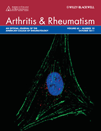Cytosolic phospholipase A2 induction and prostaglandin E2 release by interleukin-1β via the myeloid differentiation factor 88–dependent pathway and cooperation of p300, Akt, and NF-κB activity in human rheumatoid arthritis synovial fibroblasts
Abstract
Objective
Cytosolic phospholipase A2 (cPLA2) is a rate-limiting enzyme that plays a critical role in the biosynthesis of eicosanoids. The aim of this study was to investigate the mechanisms underlying interleukin-1β (IL-1β)–induced cPLA2 expression in human rheumatoid arthritis synovial fibroblasts (RASFs).
Methods
Synovial tissue was obtained from patients with RA who were undergoing joint replacement surgery. In a mouse model of IL-1β–mediated inflammatory arthritis, neutrophil infiltration, bone erosion, and cPLA2 expression in ankle synovium were analyzed by immunohistochemistry. IL-1β–induced cPLA2 expression was determined by Western blotting, real-time polymerase chain reaction, and gene promoter assay using pharmacologic inhibitors and transfection with short hairpin RNAs or small interfering RNAs. The recruitment of NF-κB and p300 to the cPLA2 promoter was determined by chromatin immunoprecipitation assay. Prostaglandin E2 (PGE2) biosynthesis was evaluated by enzyme-linked immunosorbent assay.
Results
IL-1β–induced cPLA2 expression and PGE2 release were mediated through a myeloid differentiation factor 88 (MyD88)/c-Src–dependent matrix metalloproteinase (MMP)/heparin-binding epidermal growth factor (HB-EGF) cascade linking to transactivation of the EGF receptor (EGFR)/phosphatidylinositol 3-kinase (PI 3-kinase)/Akt, p300, and NF-κB p65 pathways. IL-1β also stimulated Akt phosphorylation and nuclear translocation. Activation of Akt eventually led to the acetylation of histone residues by phosphorylation and recruitment of p300 and enhanced its histone acetyltransferase activity on the NF-κB elements of the cPLA2 promoter. IL-1β–induced NF-κB transcriptional activity was mediated through a PI 3-kinase/Akt–dependent cascade. Up-regulation of cPLA2 by IL-1β increased PGE2 biosynthesis in RASFs.
Conclusion
IL-1β–induced cPLA2 expression is mediated through activation of the MyD88/c-Src, MMP/HB-EGF, EGFR/PI 3-kinase/Akt, p300, and NF-κB pathways. These results provide insights into the mechanisms underlying IL-1β–enhanced joint inflammatory responses in RA and may inspire new targeted therapeutic approaches.




